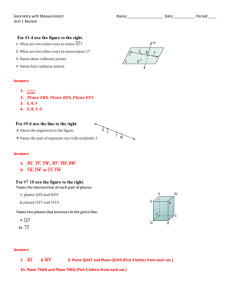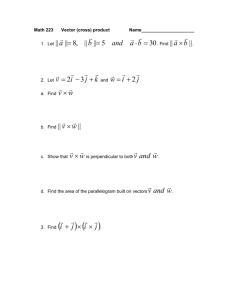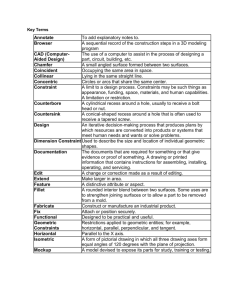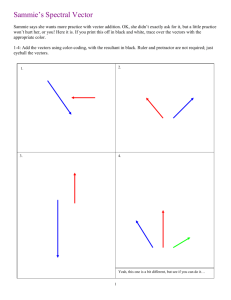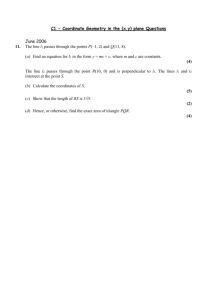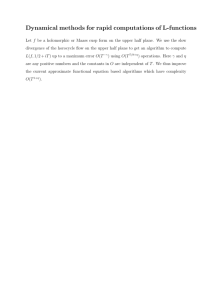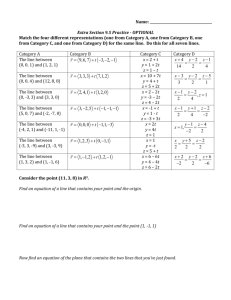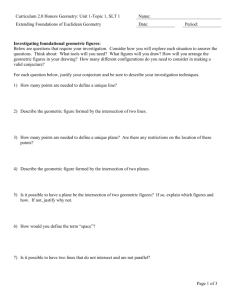3D Geometry for Computer Graphics
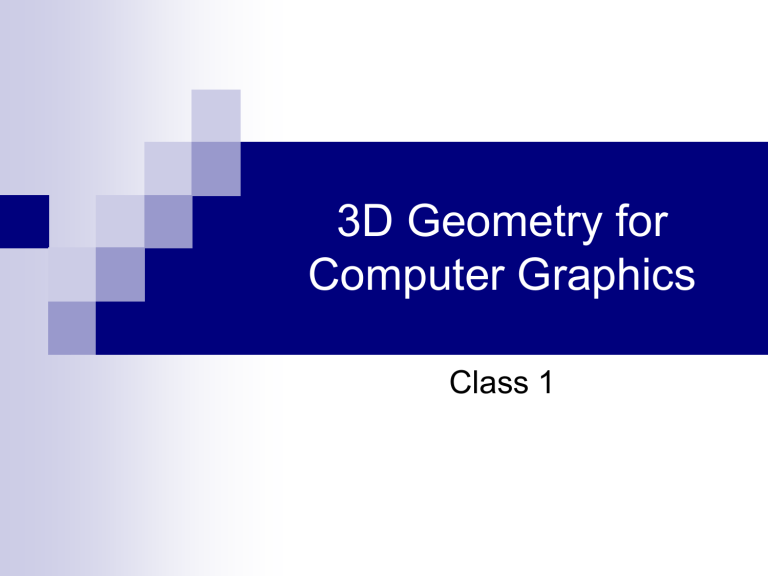
3D Geometry for
Computer Graphics
Class 1
General
Office hour: Tuesday 11:00 – 12:00 in Schreiber 002 (contact in advance)
Webpage with the slides, homework: http://www.cs.tau.ac.il/~sorkine/courses/cg/cg2006/
E-mail: sorkine@tau.ac.il
The plan today
Basic linear algebra and
Analytical geometry
Why??
Manipulation of geometry and color…
Monsters, Inc
Manipulation of geometry and color…
Manipulation of geometry and color…
Manipulation of geometry and color…
Manipulation of geometry and color…
Why??
We represent objects using mainly linear primitives:
points
lines, segments
planes, polygons
Need to know how to compute distances, transformations, projections…
How to approach geometric problems
1.
We have two ways:
Employ our geometric intuition
2.
Formalize everything and employ our algebra skills
Often we first do No.1 and then solve with No.2
For complex problems No.1 is not always easy…
Example: distance between 2 lines in 3D
Geometric problem: we have two lines (or segments) in 3D, need to find the distance between them
Example: distance between 2 lines in 3D
Geometric approach:
If we look from the direction of one of the lines, that line reduces to a point
So all we need is point-line distance in 2D (the projection plane)
By projecting, we reduced the problem from 3D to 2D
Example: distance between 2 lines in 3D
Geometric approach:
We can continue reducing the dimension!
Project the red point and the blue line on the plane perpendicular to the blue line
Now we get point-point distance
Example: distance between 2 lines in 3D
But how do we get the actual number?
Need to represent the lines mathematically
OK…
Write down the projection formulae
Have to wipe the dust off our algebra…
Compute the point-point distance
Easy
Example: distance between 2 lines in 3D
Alternative:
(Almost) skip the geometric intuition step…
Represent the lines mathematically
We know that the distance is achieved at a segment that is perpendicular to both lines
Write down the equation for that segment and solve
( p p ), u
1
2
( p p ), v
1
2 s || u ||
2 s u v
0 t || v ||
2
0
Conclusion so far:
With or without geometric intuition and good 3D orientation, in any case we need to review our algebra…
Basic definitions
Points specify location in space (or in the plane).
Vectors have magnitude and direction (like velocity).
Points Vectors
Point + vector = point
vector + vector = vector
Parallelogram rule
point - point = vector
A
A
B
B
point + point: not defined!!
Map points to vectors
If we have a coordinate system with origin at point O
We can define correspondence between points and vectors: p p
v
O + v
O
Inner (dot) product
Defined for vectors:
L
w
v
|| v || || w
cos θ
L
L
|| v ||
Projection of w onto v
Dot product in coordinates (2D) y y w y v w
O x w v x v v w
x y v v
)
( x , y w w
)
x x v w
y y v w x
Perpendicular vectors
In 2D only:
v
0 x y v v
)
v
( y x v v
) v
v
Distance between two points y y
A y
B
O x
A
A x
B
B x dist ( A , B )
|| B
A ||
B
A , B
A
( x
B
x
A
)
2
( y
B
y
A
)
2
Parametric equation of a line
p t v , t
0
( , ) p
0 v
Parametric equation of a ray
p t v , t
0
(0, ) p
0 v
Distance between point and line
Find a point q’ such that ( q
q’ )
v dist(q, l) = || q
q’ ||
, v
0 t
( p
0
t v ), v
0
, v
0 t v v
, v
0
v v
|| v ||
2
0 q p , v
0
p
0 v
2 q l
q q
||
2
|| q p
0
||
2
, v
0
|| v ||
2
2 q l q
’
= p
0
+tv
Easy geometric interpretation
Pythagoras :
(1)
(2)
L 2 q q
) 2
||
0
|| 2
L
, v
0
|| v ||
|| q q q p
0
||
)
2
2
||
||
2
0
0
, v
|| v ||
2
2
.
q p
0 v
L q’ l
Distance between point and line – also works in 3D!
The parametric representation of the line is coordinates-independent
v and p
0 and the checked point in 3D or in any dimension… q can be in 2D or
Implicit equation of a line in 2D
Ax
By C 0, , ,
A B
(0, 0) y
Ax+By+C > 0
Ax+By+C < 0 x
Line-segment intersection y
The segment Q Q intersects the line
1 2
( Ax
1
By
1
)(
2
By
2
C )
0
Q
1
( x
1
, y
1
)
Ax+By+C > 0
Q
2
( x
2
, y
2
)
Ax+By+C < 0 x
Representation of a plane in 3D space
A plane
is defined by a normal n and one point in the plane p
0
.
A point q belongs to the plane
< q – p
0
, n > = 0
The normal n is perpendicular to all vectors in the plane n q p
0
Distance between point and plane
Project the point onto the plane in the direction of the normal: dist( q,
) = ||q’ – q|| n q q’ p
0
Distance between point and plane
( q
q ) || n
q
n , q p , n
0
0
, n
0 q
0
0
p ,
0
n
2
n n
0
R
2 q
)
|| q
q ||
2
2
q
n
2
0
, n n
2
2
.
n q n q’ p
0
Distance between point and plane
Geometric way:
Project ( q p
0
) onto n !
dist
|
0
,
| n q n p
0
Implicit representation of planes in 3D
Ax
By
Cz D 0, , , ,
A B C
(0, 0, 0)
(x, y, z) are coordinates of a point on the plane
(A, B, C) are the coordinates of a normal vector to the plane
Ax+By+Cz+D > 0
Ax+By+Cz+D = 0
Ax+By+Cz+D < 0
Distance between two lines in 3D l s
1
( ) l t
2
p s u
1
p t v
2
l
1 l
2 d q
1 q
2 p
1 u v p
2
The distance is attained between two points q
1 so that ( q
1
– q
2
)
u and ( q
1
– q
2
)
v and q
2
Distance between two lines in 3D l s
1
( ) l t
2
p s u
1
p t v
2
l
2
(
( p p
1
1
p p
2
2
)
)
s s u u
t t
,
,
0
0 l
1 d q
1 p
1 u v p
2 q
2
( p p ), u
1
2
( p p ), v
1
2 s || u ||
2 s u v
0 t || v ||
2
0
Distance between two lines in 3D l s
1
( ) l t
2
p s u
1
p t v
2
l
1 d q
1 p
1 u v p
2 l
2 q
2 t s
,
, u
1
v p
||
2
2
|| v ||
2 u p
1
p
2
2 u
2 u p
1
p
2
u
2 v ||
2
,
,
1
p
2
2
Distance between two lines in 3D l s
1
( ) l t
2
p s u
1
p t v
2
l
2 l
1 d q
1 q
2 p
1 u v p
2 dist ( l
1
, l
2
)
|| l
1
( s )
l
2
( t
~
) ||
Distance between two lines in 3D
Exercise ( תושר ליגרת):
Develop the distance formula using the geometric intuition we talked about in the beginning of the class
Compare to the formula we ’ve just developed analytically
See you next time!
Barycentric coordinates (2D)
Define a point’s position relatively to some fixed points.
P =
A +
B +
C, where A, B, C are not on one line, and
,
,
R .
(
,
,
) are called Barycentric coordinates of P with respect to A, B, C (unique!)
If P is inside the triangle, then
+
+
=1,
,
,
> 0
C
P
A B
Barycentric coordinates (2D)
P
P , B , C
A
P , C , A
B
P , A , B
A , B , C A , B , C A , B , C
,
,
denotes the area of the triangle
C
C
P
A B
Example of usage: warping
Example of usage: warping
C
P
P
Tagret P
1
A
B
We take the barycentric coordinates
,
,
of P’ with respect to A’, B’, C’ .
Color( P ) = Color(
A +
B +
C )
